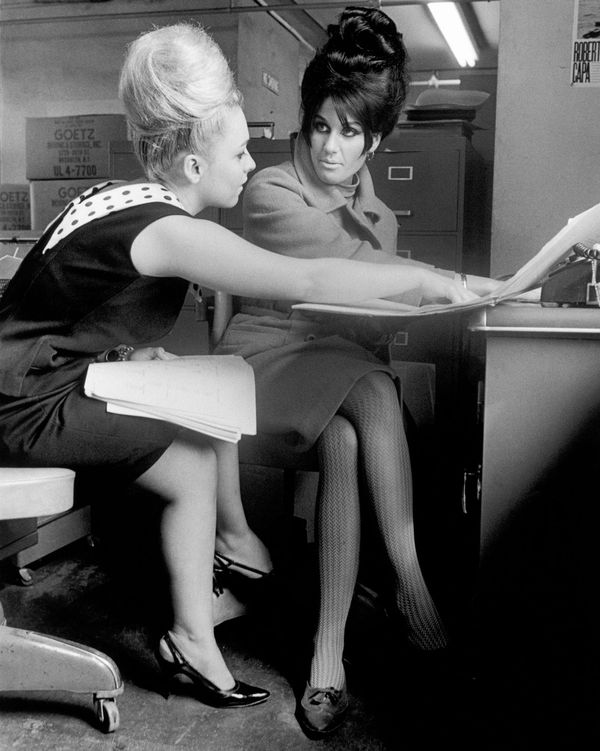
She is the first person you check in with when you arrive. It is with her that you grab a quick and unsatisfying lunch, where you both vent about the indignities of the workday thus far. When your boss does something embarrassing, it’s her eyes you seek, and when it’s time to sneak out early for happy hour, it goes without saying that she’ll come with you. She’s not a plausible romantic interest, though the suggestion is there. She might be your professional equal, but she’s equally likely not to be; she might be your boss, your report, or your direct competitor. You are dependent — possibly too much — on her emotional support within a context that perpetually degrades you. You call her your work wife, and here I must ask you: why?
In a 1933 story for the New York Times, the British journalist and British Liberal party politician Philip Whitwell Wilson attributed the term office wife to Prime Minister William Ewart Gladstone (b. 1809), who, per Wilson, used it to describe the ideal relationship between a prime minister and his secretary. By “secretary,” Gladstone referred not to the person in an office, stereotypically a woman, who answers phones and completes other administrative tasks, but a person, stereotypically a man, who serves as an adviser/ghostwriter/schmoozer beneath a prominent politician and by osmosis absorbs some of his political power. According to Gladstone, the relationship between politician and secretary should mirror that of husband and wife, except that both should be men. (Gladstone also had an actual wife named Catherine.)
The term’s modern connotations are most often attributed to the journalist David Owen, who wrote a story called “Work Marriage” for The Atlantic in 1987. Like Gladstone’s before him, Owen’s definition of “work marriage” is allegedly platonic, but unlike Gladstone (as far as I can tell, anyway), Owen explicitly explains that the appeal of a work wife lies in her being very much like your “home wife,” except she doesn’t nag you: “Your work wife would never ask you why you don’t just put your dishes right into the dishwasher instead of leaving them in the sink — she doesn’t know you do it!” he writes. “Also, she would never wedge your car between two others in the parking lot at Bradlees, sign you up to be the pie auctioneer at a church bazaar, or grab hold of your stomach and ask, ‘What’s this? Blubber?’ She knows you only as you appear between nine and five: recently bathed, fully dressed, largely awake, and in control of your life.” In other words: Your work wife finds you sexy long after the woman you married does.
Owen’s “work marriage” — and its larger cultural adaptation — is also exclusively, exhaustingly heterosexist: “close but platonic relationships that can exist between co-workers of the opposite sex.” The woman co-worker is a “wife” because that’s the only way her male superior can conceive of her presence in his place of work; no matter her job title, her primary role is to support him, and she has little to no power in her own right.
As workplaces have become less egregiously hostile to women workers, the term’s implicit meaning has morphed; sometime between the late ’80s and today, “work wife” and “work husband” became words we used to describe our friends — ostensibly our equals — at work. When used between men and women, the usage gestures at the same supposed crisis behind 1989’s When Harry Met Sally …: Can men and women ever really be just friends? Per the movie, no. In real life? Yes, obviously. What makes friendship between a man and a woman weirder than it needs to be, of course, is to enact a make-believe marriage.
There are, of course, women who have “work wives,” and though I’ve never heard a man call another man his “work husband,” I can’t prove it’s never happened. Women who call other women “work wife” tend to be straight; there the offense lies in heterosexual corniness: like your aunt who calls every friend her “girlfriend,” when, in both cases, the widely recognized word “friend” would do.
That we’ve adopted this language for co-workers reflects an overidentification with our workplaces, the result of a culture that recast workaholism as ambition and asked us to lean in and work smarter and stay hungry. Perhaps “friend” felt insufficient for those people we relied on to make such impossible conditions survivable.
But where friend is low stakes, “work wife” and “work husband” can become loaded. In 2019, the New York Times ran a “Modern Love” column by a self-identified straight woman who complained that her “work wife,” a lesbian co-worker to whose flirtatious attention the author apparently felt entitled, had made a different woman friend at work. The column served as an especially cringey reminder that work marriages, like real ones, can suffer from one-sidedness and acrimonious endings. Where real marriages require some work to untangle, work marriages can vanish as abruptly as a closed email account. Someone is fired, or quits, and that’s that.
At once suggestive and prudish — why not “work girlfriend”? Why the rush to institutionalize? — the term “work wife” belongs, spiritually, to the early aughts, alongside low-rise jeans, purity rings, and Sex and the City. What once carried an air of winking rebellion now just sounds retrograde and sad. The Lean In dream is dead, and so too is any illusion that our workplaces are where we’re most glamorous, capable, “in control of [our] life.” For those lucky enough to have kept their jobs throughout the pandemic, for those who have offices they might one day return to, the prevailing spirit seems more likely to be cautious than convivial. Workplace friendships can exist so long as work is where we spend most of our time; flirtation is bound to endure there, too. One hopes, too, that we can stop being such heteronormative squares about it. Rest in peace, work wives and work husbands; long live the work widows and widowers.





